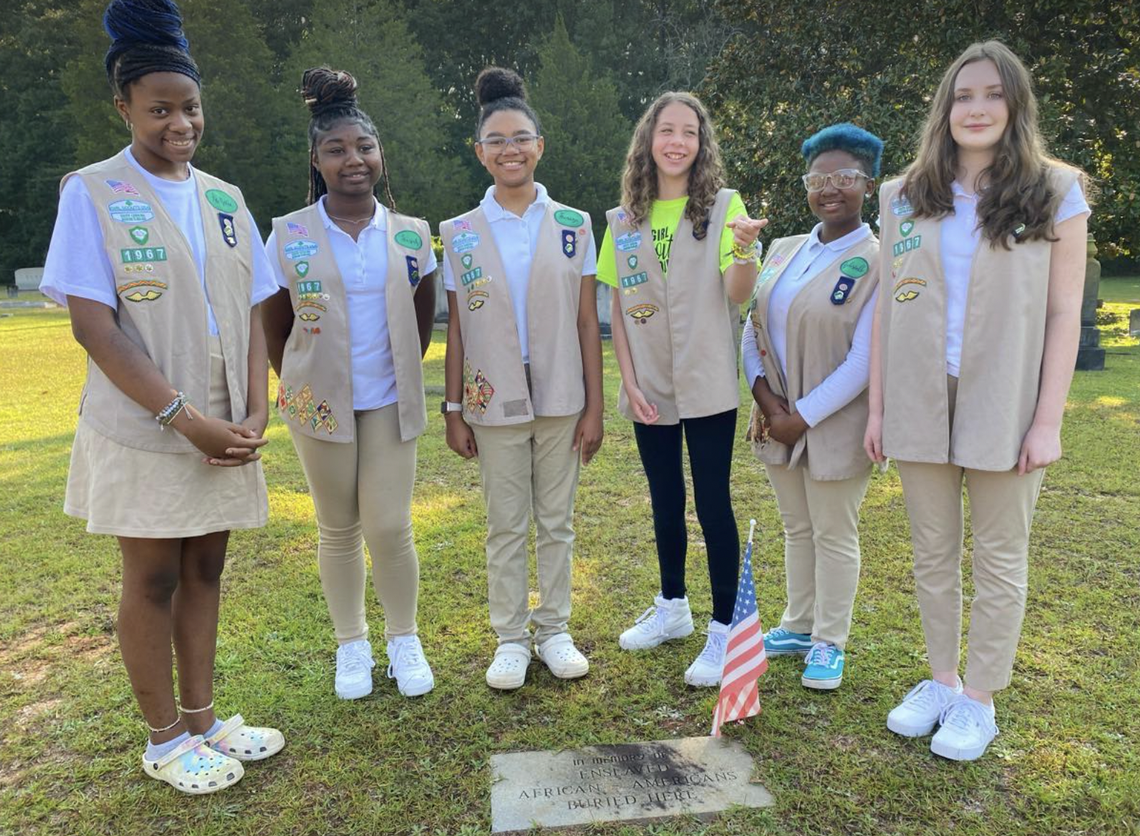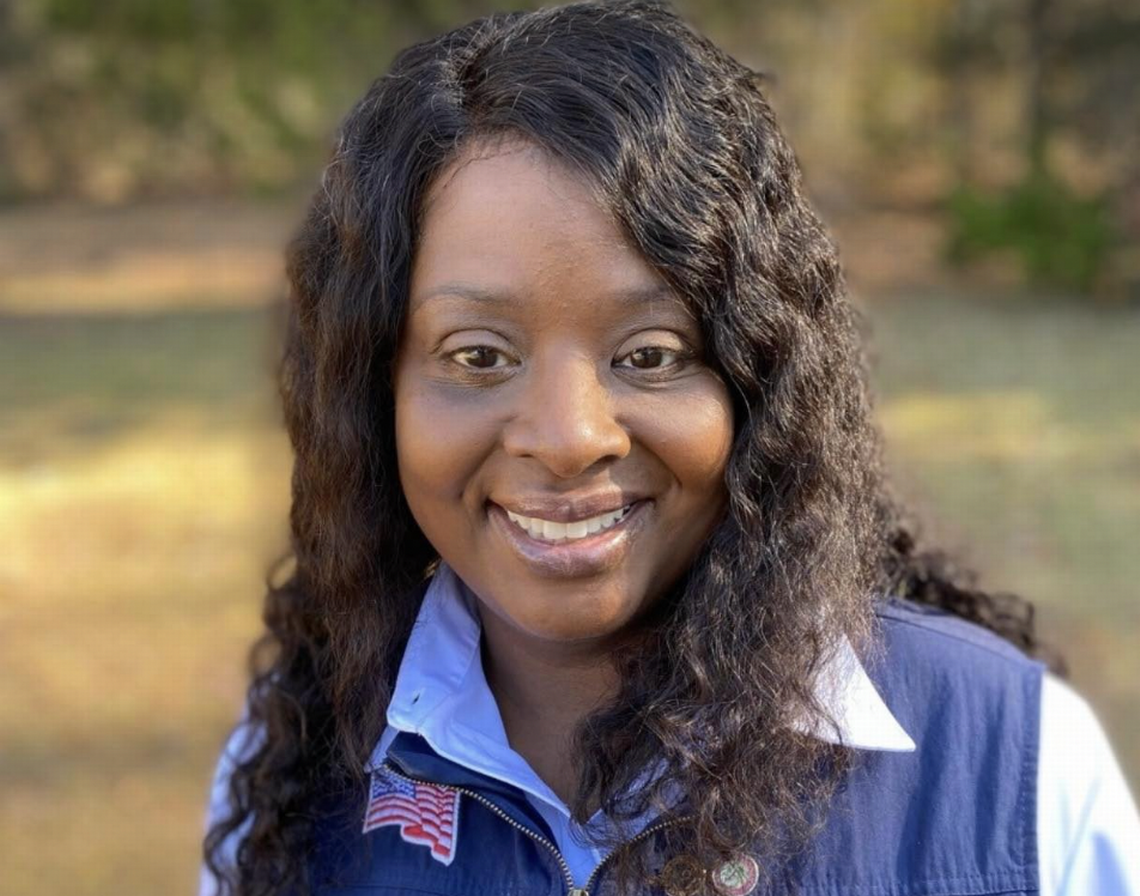An SC Girl Scout troop began mapping a historic church cemetery, then made a surprising discovery
The journey began with a simple request. Would Girl Scout troop 1967 help research who was buried in the historic Bethel United Methodist Church cemetery in Simpsonville?
Troop leader Tracey Graham, the seven middle-school-age scouts and their parents talked it over. They appreciated the church allowing them to meet on Saturdays when no other church would. They showed thanks by planting a perennial garden in front earlier.
But would the cemetery project be too macabre? Or a chance to learn to do hands-on history research? It was unanimous. They would do it.
That was mid-2020. Since then, the revelations have been more than anyone expected, including the discovery of 12 to 15 graves of people enslaved on a nearby plantation and learning the stories of people known to be buried there, not the least of which were two women who died on the same day in 1922.
The scouts learned about mapping a graveyard with radar that penetrates soil. And perhaps most revelatory of all was meeting a key figure from the cemetery’s past who could provide answers to an enduring mystery.
Researching the past
They began with the stories.

On one of their first walks through the cemetery they came upon the graves of the women, side by side, who died on the same day, Feb. 22, 1922 — Rosa McDaniel and Theodus Bramlett. They were 38 years apart — McDaniel 68 when she died, Bramlett 30.
“Two ladies are over here,” one of the scouts called over to Graham.
“Probably a house fire,” Graham responded.
Bethel is a family cemetery. Bramlett’s husband was listed on her marker, but as the troop walked around, they could not find his grave.
The troop went inside the church, fired up a computer and within a short time had the answer. The women were murdered, the scouts breathlessly yelled as they ran over to Graham. And it was Bramlett’s husband Jeff Chandle who killed them.
Later, the scouts went to the county library for more. They read a recounting from family members from the time that said Chandler had lost a leg during the Civil War and was a mean drunk. His wife left him, took their two children, ages 6 and 4, to live with her mother.
Here’s where the story goes haywire.
On that February day, he went to the mother’s house and called out to her to come outside. He fired a gun at her as his wife stepped in front of her mother. Both women were killed.
A story from the newspaper says he killed them in an upstairs room, firing six shots as the daughter watched.
One thing is undisputed. He was found guilty and died in the electric chair three years later.
Graham said troop members learned from the newspaper clippings where the house was located and on one of their research days at the county library went to see it. It’s now a Starbucks.
“People were just in there getting lattes,” Graham said. “That’s the first time I carried something home with me. I felt a heaviness.”
Enslaved people buried there
Dennis Dease, a church member, told Graham when he asked her about working on the project that it had long been rumored that enslaved people were buried there, but there were no markers, not even rocks to identify individual graves.
Graham was intrigued. He handed her a story about research Dr. Rhondda Thomas was doing at Clemson University, where she found dozens of unmarked graves, not only of enslaved people, but also of convicts who died during their time of forced labor making bricks to build buildings still standing on the campus.

She and Dease walked around. There was an open area near the back fence. They were convinced enslaved people were buried there.
Six months later Dease called Graham.
“Meet me at the church,” he said. “I want to show you something.”
When she arrived, he walked her to the center of the cemetery. There lying flat with the ground was a marker that read “In memory of enslaved African Americans buried here.”
They had only suspicions that the graves were in the open area, but now they felt certain they were there. More questions. Who put the marker there? Why was it in the center?
Modern technology arrives
The scouts set up a gofundme account to pay for someone to use ground penetrating radar to see how many graves were in the churchyard. Little by little over the past two months, in amounts of $5 up to $1,100, the troop raised the money to hire Omega Mapping Services.
Len Strozier of Fortson, Georgia, arrived earlier this month with his contraption that looks like a golf bag push cart with an iPad on the handle. He marks cemeteries all over the east coast — municipal to family plots. He said you’d be surprised how many unmarked graves there are around the country.
Sixty percent of the graves he hunts are in churchyards.
He can find them because as a body decomposes, air pockets are left that are picked up on radar. A computer records the information and GPS location, allowing him to mark them and draw a map. The radar can tell if a grave is the final resting place of an adult or a child.
“Technology has caught up,” he said.
He found 196 graves at Bethel on 1.3 acres. A dozen or so were in the area Graham and Dease suspected were enslaved African Americans. A mystery solved, but more to come.
Gilder Creek Plantation
The graves that are marked date back to 1829, Graham said. The church was organized in 1811, according to its website. It was a rallying point for Confederate soldiers and every year after the war ended soldiers would return for reunions.
“These yearly reunions were held at Bethel until 1934 when there were too few soldiers left to continue,” the church history says.
Among those looking on as the graves were mapped was Bill Austin, whose relatives have been members of the church for eight generations. He was caretaker of the cemetery for 20 years, he told Graham.
He said his family owned the African Americans buried there. His family owned a plantation house about a mile away, he said. Then he walked over to the center of the cemetery and showed her his great-great-grandfather’s grave, the enslaved workers at his feet.
Col. Bill Austin, who fought in the Civil War, had their graves moved to be close to him.
He said the graves once were marked with field stones but a minister in the 1970s who didn’t like the look of them had them pulled up and the marker installed.
Graham researched the family and Austin’s history proved true. She decided she wanted to go see the plantation house.
She went to the door, Out came Austin.
“I thought that was you,” he said.
Once people learned about the project, through the media and the gofundme page, many have offered help — historians, genealogists, people who can trace unreadable headstones.
The troop is writing a book.
Just in the past few days, a genealogist gave Graham a list of the people enslaved on the Austin plantation. Unlikely her troop will be able to mark the graves themselves, but they can erect a memorial with their names, larger and more prominent than the one now flush to the ground.
